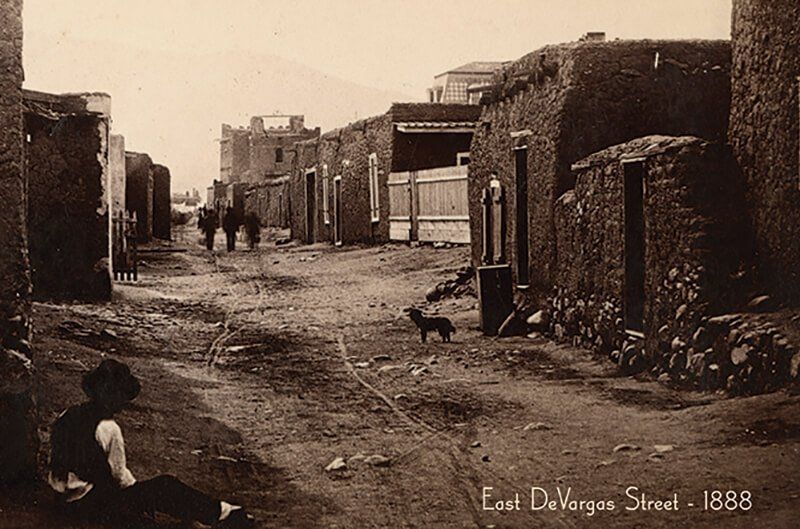About
The Five Graces
Nestled in the heart of downtown Santa Fe, often called “The City Different,” sits The Inn of The Five Graces. Set in the historic Barrio de Analco, the oldest continuously inhabited neighborhood in the U.S., the Inn’s earthy, traditional adobe and stone exterior belies the extraordinary sensual experience that awaits. A step through its doors invites a feast of color and texture that awakens the imagination. Each unique room showcases handcrafted artisan pieces and one-of-a-kind treasures from the historic Silk Road that once linked Europe and Asia. Echoes of rustic Spain, lingering in New Mexico’s Hispanic heritage, are reflected in the Seret style’s trademark synthesis of East and West. Your accommodation with us will be memorable in countless ways, but we offer more than a luxurious suite. There is much to explore beyond the Inn’s walls.


Design & Architecture
The Seret aesthetic is over 50 years in the making.
In the late 1960s and early 1970s, Ira Seret was living and working in Afghanistan, exporting and designing textiles for the New York market, and thus perfectly situated to develop the era's “ethnic chic” style. With the help of mentors Diana Vreeland and Eleanor Lambert, Ira supplied up-and-coming designers of that era—Oscar, Angelo Donghia, Halston and others—with the décor, clothing and art from Central and South Asia that shaped the style of the times.
By combining handmade carpets, silks, clothing, textiles and furnishings with interior design, Ira himself became a trendsetter. His imports—styles worn at the time by The Beatles and Jimi Hendrix—fueled the sheepskin coat craze. Starting with the single purchase of a then unknown rug type in Multan, one of the oldest cities in South Asia, Ira brought the dhurrie rug trend to America via Stark Carpet along with his East End and 87th Street apartment and showroom. This showroom was the genesis of the layered look of carpet, silks and other textiles that became his signature, and what Vreeland said reminded her of Whistler’s Peacock Room. Ira’s ten-year Silk Road adventure inspired a lifetime of entrepreneurship and exchange of artistic ideas, with a mission of bridging East and West through architecture and design. Through this effort, he began to support the livelihoods of a multitude of craftsman and artisans.
What began as collaged furnishings he crafted himself in 1970 began to evolve in the early 1980s, when Ira and his wife Sylvia and their first son, arrived in Santa Fe. By covering furniture made from scratch in their Santa Fe workshop in kilim, carpet, dhurrie and other textiles, one-of-a-kind pieces have remained Ira’s signature style ever since. The aesthetic evolved further by reshaping, or using pieces of architectural elements, to design beds, tables, ceilings and entire installations. His unequalled style has furnished homes, hotels, and theme parks around the world.
In 1994, Ira and Sylvia bought a cluster of buildings on historic East DeVargas Street, in the oldest continually inhabited neighborhood in the country. The old adobe buildings became a showcase for both Ira’s signature style and Sylvia’s mosaic art, bringing their combined artistry together with masterful sensibility. With each year’s remodel, the design ideas evolved to another level, providing new inspiration for clients at the Seret & Sons shop, just two blocks away on Galisteo Street. Thus began The Inn of The Five Graces, named for the Eastern concept that we are graced with five ways to experience the splendor of the world: sight, sound, taste, smell and touch.
The blending of artisanal pieces with intricate tile mosaics in The Inn’s bathrooms became a hallmark for the Seret aesthetic. A harmonious melange of cultural elements, the sensibilities of the traditional arts of diverse cultures, the bejeweled rooms housed in centuries-old adobe walls—all contribute to the unmatched splendor that makes The Inn so intriguing. Guests often proclaim there is a soothing, subtle energy present from the countless hours of artisans’ handiwork that has gone into each and every room. The Inn is a place where one is invited to leave the mundane behind, embarking on a visual odyssey, a feast for the senses that is hospitality at its very finest.
Bringing the East to the West—and into the spot where the Silk Road meets Old Santa Fe Trail—has become the Seret’s life work.
Learn more about the journey of Ira and Sylvia Seret through this short film about them entitled, "Weaving Destiny".


Santa Fe &
The Inn of The Five Graces
Santa Fe is an ancient city by American standards. Five hundred years before the arrival of the Spanish in 1540 there were Pueblo villages here, 7,000 feet above sea level. Tiny houses and large buildings alike were constructed of a durable mixture of mud and straw called adobe. The city – the oldest state capital in the country – was wrought with battles between the Conquistadors and Pueblo Indians for control of the area. Three hundred years later, New Mexico became a United States Territory in 1846, and a state in 1912. Robust trade began by way of the Santa Fe Trail; and the fresh clear air and dry climate brought many people seeking a cure for tuberculosis. The Inn of The Five Graces anchors the historic, 17th century Barrio de Analco, or Quarter “Across the Water” in the language of the Mexican Tlaxcalpa Indians, who came to Santa Fe in 1598 with the Spanish. This is the oldest inhabited block in the United States.
Across Old Santa Fe Trail from the hotel is the San Miguel Mission, the oldest church in the United States, and next to it, the oldest house. The extensive, multi-cultural history of Santa Fe, encompassing many religions, languages, and artistic traditions, gives the city a unique fascination today. Walk its winding streets and experience the romance of the past, entwined with the vibrant culture of today.
